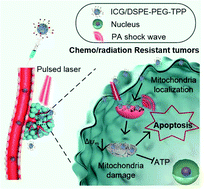Undifferentiated destruction of mitochondria by photoacoustic shockwave to overcome chemoresistance and radiation resistance in cancer therapy†
Abstract
Resistance to either radiation or chemotherapy remains a complex and stubborn obstacle in cancer therapy and is responsible for a significant portion of the treatment failure. While the underlying mechanisms of the resistance are often associated with multiple factors, direct destruction of mitochondria is likely to ensure the ultimate death of the cell. Herein, a strategy of precise mitochondrial destruction using a photoacoustic (PA) shockwave was proposed to overcome chemoresistance and radiation resistance in cancer therapy. A nanoparticle featuring mitochondria-targeting and high near-infrared absorbance is constructed. The nanoparticle was found to indiscriminately localize in the mitochondria of both parental and its corresponding resistant tumor cells due to the mitochondrial transmembrane potential. By absorbing a controllable amount of energy from a pulsed laser, the nanoparticle could generate a mechanical PA shockwave that physically damages the mitochondria leading to the opening of apoptotic pathways and thus yielding a precision antitumor effect. The cell-killing efficiency was validated in vitro and in vivo. The results demonstrate that a PA shockwave can result in undifferentiated killing of the resistant tumor cells via destruction of mitochondria. Given the critical importance of resistant tumor cells, although at its preliminary stage, the proposed modality may open a new window in cancer therapy.



 Please wait while we load your content...
Please wait while we load your content...